What is — and what is not — a fedora
THE DEFINITIVE GUIDE TO WHAT HAT IS THAT
 If you have been reading this blog for a little while, you will know that I love hats. While I am not a trained milliner, I do own a lot of hats (over 300) and books about hats, which I sometimes even read (as opposed to drooling over the pictures). I scour the internet for strange and wonderful hats, and for a long time I have been looking for the perfect 1930s or 1940s fedora. I already own one (pictured above), which I love for its film noir aspect, but I would love one more that has a more exaggerated shape, specifically in a colour I love (not black or brown, which are more ubiquitous).
If you have been reading this blog for a little while, you will know that I love hats. While I am not a trained milliner, I do own a lot of hats (over 300) and books about hats, which I sometimes even read (as opposed to drooling over the pictures). I scour the internet for strange and wonderful hats, and for a long time I have been looking for the perfect 1930s or 1940s fedora. I already own one (pictured above), which I love for its film noir aspect, but I would love one more that has a more exaggerated shape, specifically in a colour I love (not black or brown, which are more ubiquitous).
What I am finding however, is that vintage sellers seem to apply the word ‘fedora’ to any vaguely mannish hat, and I’m not sure if that’s because some of them aren’t really clear on the proper definition of a fedora, or because it is an extremely popular search term – I’ve seen it applied as a keyword for a frothy pink, flower-bedecked garden party hat! Today, however, I am going to clear up any misconceptions about what is – and what is not – a fedora, with a few key, easy-to-remember points to identify these same, same but different hats.
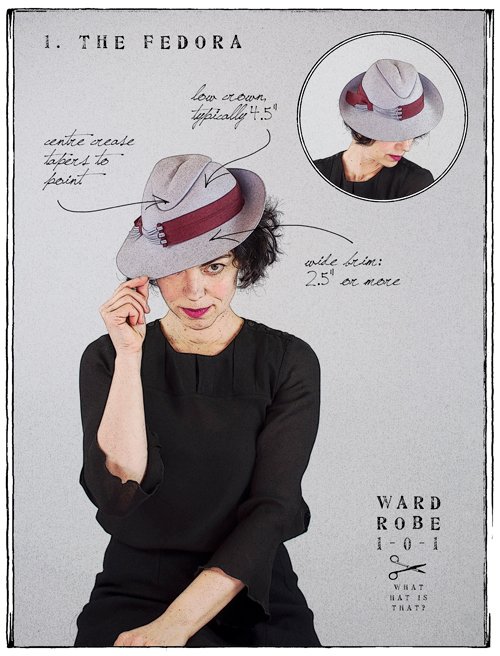 The Fedora
The Fedora
The fedora takes its name from an 1891 stage play, about a cross-dressing Princess Fedora who wears a centre-creased, soft wide-brimmed hat. Traditionally the crease is pinched at the front, forming a point or teardrop shape, but the crease can include diamond shaped crowns, and the positioning of dents can vary. Many other hats have centre dents, but the fedora combines this with a low crown – 4.5” or 11cm – and a wider brim of at least 2.5” or 6.4cm but they can be much wider, particularly in exaggerated fashion versions. The brims can be left raw, or stitched, or finished with ribbon-trim. This is the hat worn by Humphrey Bogart in the film Casablanca.
Key Points
- Low crown
- Centre crease pinched at front
- Wide brim
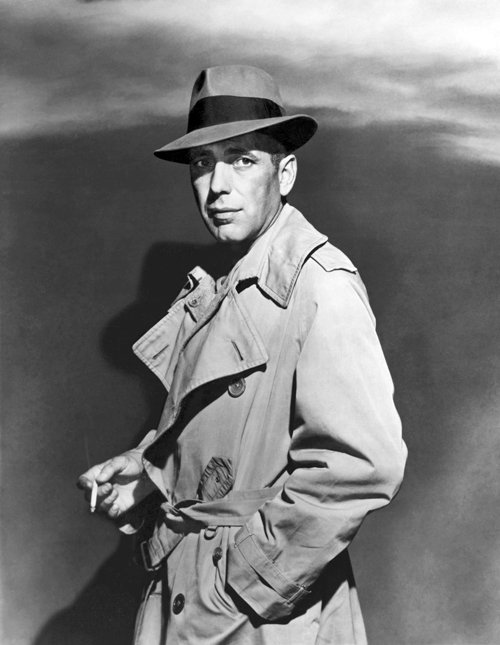 Humphrey Bogart in Casablanca; image found on Pinterest
Humphrey Bogart in Casablanca; image found on Pinterest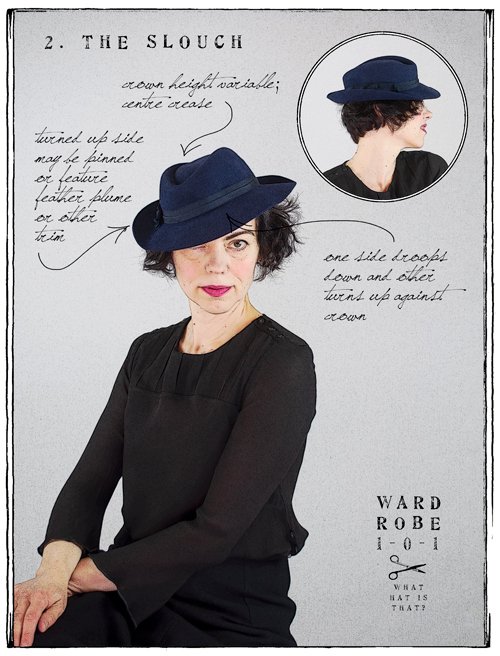
The Slouch
The next hat most commonly confused with a fedora, as far as I can discern, is the slouch hat. This is a style of hat traditionally worn by Australian soldiers (and those of many other nations), and is distinguished mainly with one side of the brim being turned up towards the crown, and one dipped down. The military hat has a fairly low crown, and the turned-up side is usually pinned to allow a rifle to be slung over the shoulder. Fashion versions vary in crown heights, but both feature a centre crease. Where the military hat is pinned up, the fashion hat may simply be decorated with trim on one side.
Key Points
- One side turned up, one side dipped down
- Crown height and brim width variable
- In place of the military pin, fashionable trim
 Australian soldier wearing a slouch in 1916; image found on Pinterest
Australian soldier wearing a slouch in 1916; image found on Pinterest
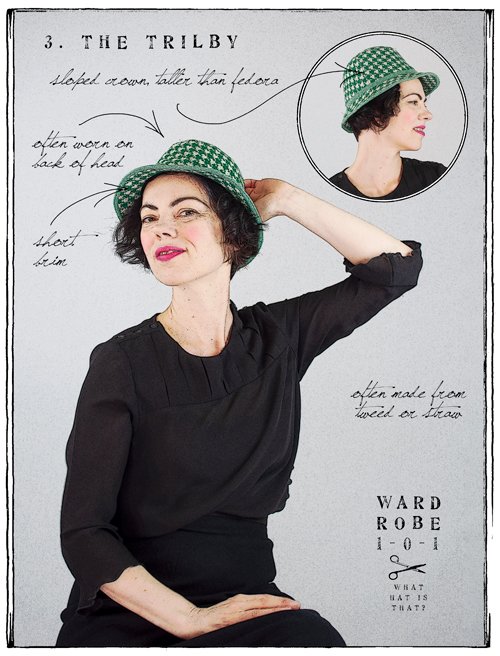 The Trilby
The Trilby
Another ubiquitous hat which can also be confused for a fedora is the trilby. Surprisingly, this is another hat whose inception lies in a stage play around the same time! George du Maurier’s 1894 novel Trilby was translated to the stage in London, and a hat of this shape was worn. Though the hat was worn by a woman, it became popular for men shortly after. It’s often made of tweed, like mine, or in straw for summer, though more properly its short brim is snapped up at the back. It has a much taller crown than a fedora, with sloped sides, and a popular hat with musicians, it is often worn on the back of the head. Sean Connery is well-known for wearing a trilby.
Key Points
- Short brim, usually snapped up at back
- Taller crown with sloping sides
- Designed to be worn further back on the head
 Sean Connery wearing a trilby; image found on Pinterest
Sean Connery wearing a trilby; image found on Pinterest
 The Homburg
The Homburg
The homburg is quite a masculine hat that has not really been translated into women’s versions, but this turquoise felt hat I own does not really fall into any other style, so I am using it to illustrate this style, perhaps most famously worn by Winston Churchill. Its most distinctive feature is the pencil-curled brim (which mine does not have at all). The hat is usually made of hard felt, with straight sides and a pronounced and quite wide centre crease. It is still a very popular hat shape for men today – and gangsters of all eras! Michael Corleone of The Godfather, and Nucky Thompson of Boardwalk Empire both present fine examples of the homburg’s sinister aspect.
Key Points
- Short, curled brim
- Taller crown with straight sides
- Wide, shallow centre crease
 Winston Churchill was famous for his homburg; image found on Pinterest
Winston Churchill was famous for his homburg; image found on Pinterest
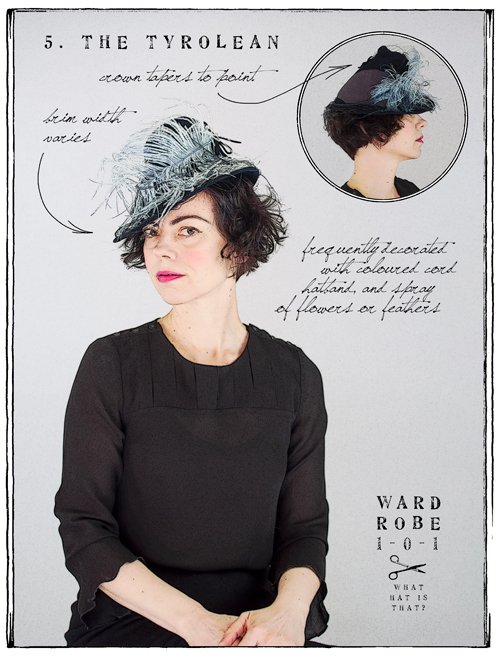
The Tyrolean
The Tyrolean hat style is one of my favourite jaunty styles! It originates from the Tyrol in the Alps, in what is now variously Austria, Germany, Italy and Switzerland. Its most distinctive feature is the crown that rises to form a point. The brim traditionally was roughly the width of a hand, and the hat was usually decorated with hatband made of coloured cord and a spray of flowers, feathers or brush. However, brims and crown heights varied in different parts of the Tyrol. Also known as a Bavarian or Alpine hat, it was originally made from green felt. Fortunately, fashion versions are not so limited in scope. Mine is navy, trimmed in a wide grosgrain band, netting, and a light blue ostrich feather. Edward VIII stayed in Austria after his abdication and often wore the hat, popularising its style.
Key Points
- Crown tapers to a point
- Crown height and brim width varies
- Decorated with flowers or feathers
 Edward VIII made the Tyrolean hat famous after his abdication
Edward VIII made the Tyrolean hat famous after his abdication
In Conclusion
Of course, it must be remembered that these key points are only guidelines for identifying a general style – they are not hard and fast rules. Fashion hats often take inspiration from traditional styles and designers will add their own twist, pushing and pulling them in exaggerated directions, creating hybrids with brilliant details and wonderful new ideas. A hat should be the exclamation point of an outfit, the finishing touch to delight the eye – much more than a conservative tradition. But it’s always good to know the rules before you break them.
Photos: September 2019

